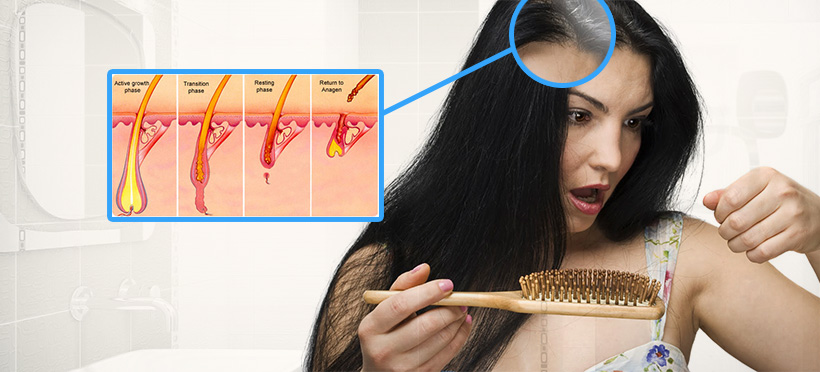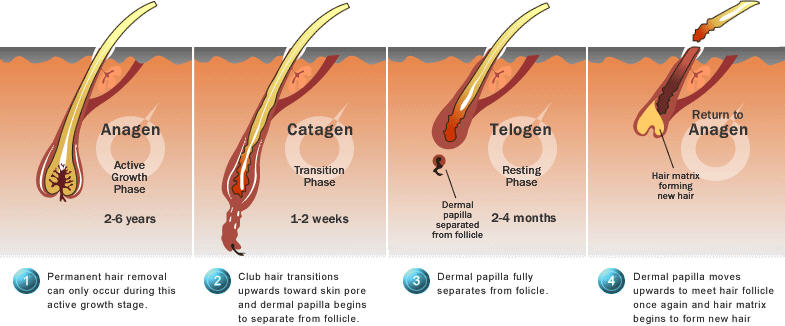About
Hair Loss
How Does Hair
Loss Occur?

A reported 50% of men experience
hair loss prior to age 50 and overall about 80% of men experience hair
loss in their lifetime.. Female hair loss is a relatively less common,
however still affects a staggering 20-30 million women in America alone.
There are a number of different factors that are known to cause hair loss,
including:
-
Heritability (genetics)
-
Thyroid imbalance
-
Excessive DHT production
-
Certain prescription medications
-
Stress and mental/emotional trauma (telogen
effluvium)
-
Physical trauma (traction alopecia)
Hair Growth,
Loss, and Treatment:
To better understand the benefits
of treating hair loss with low level laser therapy, it helps to first understand
how hair grows:
The Structure of Hair
The strand of hair which is visible above
the skin is called the hair shaft. The section of hair that lies
under the skin is called the hair root. The hair root resides inside
a hair follicle. Rapidly dividing cells project from a structure
called the dermal papilla into the hair follicle and pack together
to form the hair shaft.
The Growth Cycle of Hair
The hair growth cycle consists of 3 stages.
Ninety percent of the hair on your scalp is either in the anagen or catagen
phase at any one time. No more than ten percent is usually in the telogen
phase at any given time.

-
Anagen Phase: The first
of the three stages is the anagen phase. This is also called the
growth
stage. In this stage of the hair cycle, the hair shaft is actively
growing inside the follicle, with new rapidly dividing cells being supplied
by the dermal papilla. This stage typically lasts between 2 and 8 years.
-
Catagen Phase: The second
of three stages of hair growth is called the catagen phase. This is also
called the degradation phase and is a transitional phase where the
hair follicle pulls away from the dermal papilla. Since the hair follicle
is no longer being supplied with the new cells from the dermal papilla,
the hair stops growing. This stage is brief, usually lasting about 2-4
weeks.
-
Telogen Phase: The last
of the three stages is called the telogen phase. This is also known as
the resting phase. During this stage, the hair follicle remains
inactive and the hair shaft usually stays in place until the follicle cycles
back to the anagen phase where the new hair shaft emerges and pushes out
the old one. This lasts about 2-4 months.
Follicle Health
and Hair Growth:
Hair follicles are the foundation on which
healthy strands of hair are grown. It is the follicle that supplies the
root of the hair with the oxygen, nutrients, and support needed to flourish
during the anagen phase. The follicle also plays a vital role in supporting
hair as it transitions through the catagen phase. During telogen phase,
the hair follicle rests in preparation for new hair growth.
Though much is still being discovered about
the root causes of hair loss, research shows that many hair loss conditions
are associated with certain conditions that impair hair follicle health
and function. To illustrate, consider:
-
Telogen effluvium (stress related hair
loss) occurs after a stressful event causes enough trauma to shock the
follicles into an inactive state. The hair loss condition receives its
name from the telogen phase in which follicles become stuck.
-
Androgenetic alopecia (pattern baldness)
is correlated with high levels of DHT on the scalp. DHT is thought to penetrate
the scalp and cause
hair follicle miniaturization, a phenomenon
in which follicles become smaller and eventually incapable of supporting
a healthy hair growth cycle.
Recognizing
Hair Loss Early:
Hair loss physicians agree: Early
diagnosis and treatment is the best way to restore areas of thinning or
receding hair. When caught early, men and women have a strong chance of
restoring their luscious locks.
Some hair loss is normal. It is
normal to lose about 50-100 hairs each day as they enter the telogen
phase described above. These hairs are typically found on hair brushes,
in the shower, and on other personal care items.
Excessive hair loss is NOT normal.
Losing more than 100 hairs each day is a sign of abnormal hair loss in
both men and women. Excessive hair accumulation may occur around the shower/sink
drain, on combs and brushes, on your pillows, on furniture, and in your
sheets.
Treating Hair
Loss with Capillus®:
No matter what the cause of hair
loss, one thing remains certain: The best way to reverse the signs of thinning,
shedding, and balding is to treat it early. Low level laser therapy devices
are physician-recommended tools designed to help strengthen hair follicles
and produce all-natural healthy hair from the inside, out. Capillus®
treats
the Dysfunctional hair follicles.


|


